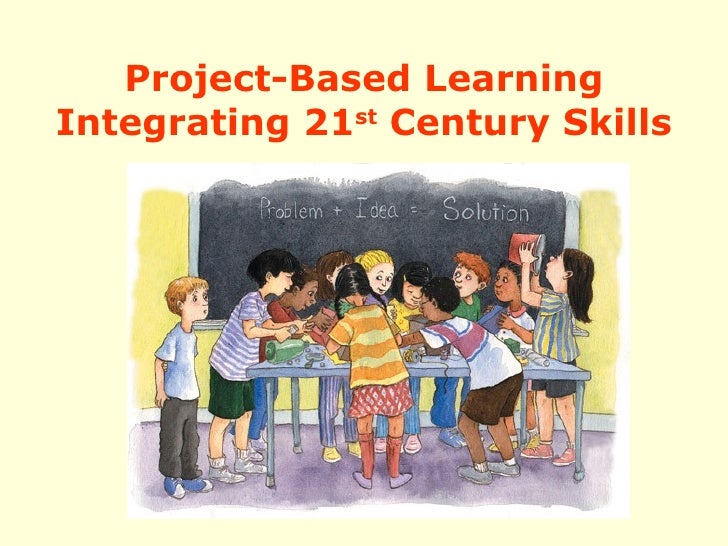A project based learning method is a comprehensive approach to instruction. Your students participate in projects and practice an interdisciplinary array of skills from math, language arts, fine arts, geography, science, and technology.
"The collaborative nature of the investigation enhances all of these valuable experiences ... as well as promotes a greater appreciation for social responsibility (Scott, 1994)."

Defining Project-Based Multimedia Learning
It's best to start with some definitions. By project-based learning, we mean a teaching method in which students acquire new knowledge and skills in the course of designing, planning, and producing some product or performance. By multimedia, we mean the integration of media objects such as text, graphics, video, animation, and sound to represent and convey information. Thus, our definition is:
Project-based multimedia learning is a method of teaching in which students acquire new knowledge and skills in the course of designing, planning, and producing a multimedia product.
Your students' multimedia products will be technology-based presentations, such as a computerized slide show, a Web site, or a video. These presentations will include evidence that your students have mastered key concepts and processes you need to teach and will be a source of great pride for them and for you.
Many present day activities focus on developing linguistic competence for example, the ability to use lexics, grammar and phonetics of the language. They also develop the pragmatic abilities of the learners to use the language for real-life communication. The activity of project-based multimedia learning stimulates through process in learners by forcing them to think and make decision.
The purpose of our report is to show the content of the method of project-based multimedia learning, the usage and the implementation it in teaching English process through distance education.
Project-based learning is an old and respected education method. The use of multimedia is a dynamic new form of communication. The merging of project-based learning English and multimedia represents a powerful teaching strategy that is called “project-based multimedia learning”.
Project-based multimedia learning is a method of teaching in which students acquire new knowledge and skills in the course of designing planning and producing a multimedia product.
Project-based multimedia learning has seven key dimensions such as core curriculum, real-world connection, extended time frame, students decision making, collaboration, assessment, multimedia.
Here is a brief explanation of each.

Core curriculum. At the foundation of any unit of this type is a clear set of learning goals drawn from whatever curriculum or set of standards is in use. We use the term core to emphasize that project-based multimedia learning should address the basic knowledge and skills all students are expected to acquire.
Real-world connection. Project-based multimedia learning strives to be real. It seeks to connect students’ work with the wider world in which students live.
Extended time frame. A good project is not a one-shot lesson; it extends over a significant period of time. The actual length of a project may vary with the age of the students and the nature of the project.

Students decision making. In project-based multimedia learning, students have a say. Teachers look carefully at what decisions have to be made and divide them into “teacher’s” and “students” based on a clear rationale.
Collaboration. We define collaboration as working together jointly to accomplish a common intellectual purpose in a manner superior. Students may work in pairs or in teams of as many as five or six. Whole-class collaborations are also possible. The goal is for each students involved to make a separate contribution to the final work.
Assessment. Regardless of the teaching method used, data must be gathered on what students nave learned. When using project-based multimedia learning, teachers face additional assessment challenges because multimedia products by themselves do not represent a full picture of student learning. Students are gaining content information, becoming better team members, solving problems and making choices about what new information to show in their presentations. We consider assessment to have three different roles in the project-based multimedia context:
- Activities for developing expectations;
- Activities for improving the media products;
- Activities for compiling and disseminating of learning.
Multimedia. In multimedia projects, students do not learn simply by “using’ multimedia produced by others. As students design and research their projects, instead of gathering only written notes, they also gather and create pictures, video clips, recording and other media objects that will serve as the raw material for their final product.

What value does the teacher add when she implements project-based multimedia learning? The answer of this question lies in the concept of “value added”. Richard Murnane and Frank Levy (1996) describe three skills sets students need to be competitive for today’s job. These are hard skills (math, reading, problem-solving skills , mastered at a much higher level than previously expected of high school graduates); soft skills (the ability to work in a group and to make effective oral and writing presentations); and the ability to use personal computer to carry out routine tasks (for example, word processing, data management and creating the multimedia presentations).
If means that high school graduates need to master a combination of foundation skills and competencies. These are exactly the soft skills students learn when engaged in project-based multimedia learning.

Adding Project-Based Multimedia Learning to Your Teaching Repertoire
Being a teacher is a bit like being a personal trainer. In general, a trainer knows that all clients need a balanced workout. They need to develop muscular strength, flexibility, and aerobic fitness. They also need to adhere to a sound, balanced diet. At the same time, each client will have specific needs or conditions that require accommodation. The workout you design for your client with asthma will be different from the one you create for your client with arthritis.
Likewise, effective teachers employ various teaching methods to achieve a balanced instructional program that is also personalized and reflects the needs and interests of individual students. You know that your students need a balanced diet of academic content and process skills—and workouts that include learning, practicing, analyzing, reflecting, and assessing. You also know that students vary in their comfort with these activities and the amount of support they need.
· Honing their planning and organizational skills;Project-based multimedia learning is one instructional strategy that you can use in a school year that may also include non-technical projects, lecture and note-taking, rote practice, writing, and artistic or creative work. During this part of the year, students may be spending less time on rote practice and the breadth of material they cover may be smaller. What they will be doing instead includes:
· Learning
to present information in compelling ways;
· Synthesizing
and analyzing complex content and data;
· Practicing
research and technical skills; and
· Learning
how academic subject matter applies to the real world.
Further, the motivational character keeps
students engaged, giving you the freedom to support individual students—far
better than when every moment of instruction depends on you alone.
.jpg)
No comments:
Post a Comment